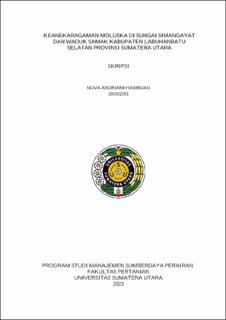| dc.description.abstract | Simangayat River is located in Torgamba District, Soulth Labuhanbatu Regency, North Sumatera Province, Simangayat is tributary upstream and empties into the Barumun River, Local people use this river in fishing This river is also a place for wastewater disposal from household, industry, as well as agricultural and fishery activities, these activities certainly have an impact on water quality. These activities will indirectly have a negative impact on changes in water quality and can also affect the life of biota living in these waters. One of the biota directly affected by changes in water quality is Mollusks. Mollusks are organisms that live on the surface of the substrate and in the aquatic substrate. Mollusks are one of the phyla of the kingdom Animalia in which there are the largest classes, namely Bivalves and Gastropods.Mollusk diversity has the potential to describe the state or conditions in a water. This study aims to determine the density of mollusks, diversity of mollusks and the relationship between density, diversity, diversity and water quality in the Simangayat river and Samak Reservoir, South Labuhanbatu Regency, North Sumatra Province. The method used is a survey method with sampling using the Purposive Sampling method. Samples were taken at 2 stations and each station consisted of 3 points. The determination of station locations is due to different ecological characteristics. In the river (station I) samples were taken on plots with a minimum size of 20 x 4.5 meters by adjusting the conditions of river waters, while reservoirs (station II) on plots measuring 20 x 20 meters. The results stated that 3489 individuals from the Bivalve class and 139 individuals from Gastropoda were found. The characteristics of the substrate at Station I, namely the Simangayat River, are clay clays with an organic matter content of 4%. and Station II, which is a dusty clay reservoir with organic matter levels ranging from 9%. The highest mollusk population density at station I was 6.18 ind/m2 while the lowest density at station II was 2.47 ind/m2. At station I the Index value H'=1.15 low category, E=0.55 medium category, C=0.42 medium category. At station II the index value H'=1.33 low category, E=0.64 medium category, C=0.49 medium category. | en_US |





